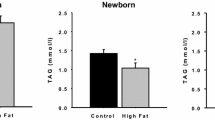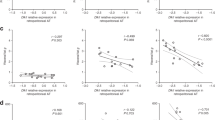Abstract
Intrauterine growth restriction (IUGR) with rapid catch-up growth leads to adult obesity and insulin resistance. We have previously shown that IUGR male rats demonstrated increased de novo fatty acid synthesis in the subcutaneous (SC) fat, but not the visceral fat, during the nursing period prior to the onset of obesity. Young IUGR females do not exhibit the same increase. We further hypothesized that in male IUGR offspring, de novo synthesis is a programmed intrinsic effect that persists to adulthood and does not suppress in response to a high fat diet. We measured fatty acid de novo synthesis in IUGR adult males (6 months) using deuterium-enriched drinking water as a stable isotope tracer, then further studied the response after consumption of an isocaloric high fat diet. Baseline de novo synthesis in adult females was also studied at age 9 months. Males demonstrated increased baseline de novo synthesis in both SC fat and visceral fat. Correspondingly, SC and visceral fat protein expression of lipogenic enzymes acetyl-coA carboxylase-α (ACCα) and fatty acid synthase were upregulated. After the isocaloric high fat diet, de novo synthesis was suppressed such that no differences remained between the two groups, although, IUGR SC fat demonstrated persistently increased lipogenic protein expression. In contrast, de novo synthesis among adult females is not impacted in IUGR. In conclusion, enhancement of male IUGR SC fat de novo synthesis appears to be an early consequence of metabolic programming, whereas enhancement in visceral fat appears to be a later consequence.




Similar content being viewed by others
Abbreviations
- IUGR:
-
Intrauterine growth restriction
- SC:
-
Subcutaneous
- ACCα:
-
Acetyl-coA carboxylase alpha
- FASN:
-
Fatty acid synthase
- SREBP1:
-
Sterol regulatory element-binding protein 1
- ChREBP:
-
Carbohydrate response element binding protein
- GC/MS:
-
Gas chromatography/mass spectrometry
- FNS:
-
Fractional new synthesis
- FABP4:
-
Fatty acid binding protein 4
References
Martin JA, Hamilton BE, Osterman MJ, Curtin SC, Matthews TJ (2015) Births: final data for 2013. Natl Vital Stat Rep 64:1–65
Ortigosa Rocha C, Bittar RE, Zugaib M (2010) Neonatal outcomes of late-preterm birth associated or not with intrauterine growth restriction. Obstet Gynecol Int 2010:231842
Ravelli AC, van Der Meulen JH, Osmond C, Barker DJ, Bleker OP (1999) Obesity at the age of 50 years in men and women exposed to famine prenatally. Am J Clin Nutr 70:811–816
Barker DJ, Gluckman PD, Godfrey KM, Harding JE, Owens JA, Robinson JS (1993) Fetal nutrition and cardiovascular disease in adult life. Lancet 341:938–941
Desai M, Gayle D, Babu J, Ross MG (2005) Programmed obesity in intrauterine growth-restricted newborns: modulation by newborn nutrition. Am J Physiol Regul Integr Comp Physiol 288:R91–R96
Lane RH, MacLennan NK, Hsu JL, Janke SM, Pham TD (2002) Increased hepatic peroxisome proliferator-activated receptor-γ coactivator-1 gene expression in a rat model of intrauterine growth retardation and subsequent insulin resistance. Endocrinology 143:2486–2490
Desai M, Ross MG (2011) Fetal programming of adipose tissue: effects of intrauterine growth restriction and maternal obesity/high-fat diet. Semin Reprod Med 29:237–245
Joss-Moore LA, Wang Y, Campbell MS, Moore B, Yu X, Callaway CW, McKnight RA, Desai M, Moyer-Mileur LJ, Lane RH (2010) Uteroplacental insufficiency increases visceral adiposity and visceral adipose PPARgamma2 expression in male rat offspring prior to the onset of obesity. Early Hum Dev 86:179–185
Yee JK, Lee WN, Han G, Ross MG, Desai M (2011) Organ-specific alterations in fatty acid de novo synthesis and desaturation in a rat model of programmed obesity. Lipids Health Dis 10:72
Strable MS, Ntambi JM (2010) Genetic control of de novo lipogenesis: role in diet-induced obesity. Crit Rev Biochem Mol Biol 45:199–214
Olefsky JM (2008) Fat talks, liver and muscle listen. Cell 134:914–916
Hudgins LC, Hellerstein M, Seidman C, Neese R, Diakun J, Hirsch J (1996) Human fatty acid synthesis is stimulated by a eucaloric low fat, high carbohydrate diet. J Clin Invest 97:2081–2091
Wright JD, Wang CY, Kennedy-Stephenson J, Ervin RB (2003) Dietary intake of ten key nutrients for public health, United States: 1999–2000. Adv Data 334:1–4
Belkacemi L, Chen CH, Ross MG, Desai M (2009) Increased placental apoptosis in maternal food restricted gestations: role of the Fas pathway. Placenta 30:739–751
Lee WN, Bassilian S, Lim S, Boros LG (2000) Loss of regulation of lipogenesis in the Zucker diabetic (ZDF) rat. Am J Physiol Endocrinol Metab 279:E425–E432
Desai M, Gayle D, Han G, Ross MG (2007) Programmed hyperphagia due to reduced anorexigenic mechanisms in intrauterine growth-restricted offspring. Reprod Sci 14:329–337
Lowenstein JM, Brunengraber H, Wadke M (1975) Measurement of rates of lipogenesis with deuterated and tritiated water. Methods Enzymol 35:279–287
Lee WN, Byerley LO, Bergner EA, Edmond J (1991) Mass isotopomer analysis: theoretical and practical considerations. Biol Mass Spectrom 20:451–458
Romero-Calvo I, Ocon B, Martinez-Moya P, Suarez MD, Zarzuelo A, Martinez-Augustin O, de Medina FS (2010) Reversible Ponceau staining as a loading control alternative to actin in Western blots. Anal Biochem 401:318–320
Desai M, Jellyman JK, Han G, Beall M, Lane RH, Ross MG (2014) Maternal obesity and high-fat diet program offspring metabolic syndrome. Am J Obstet Gynecol 211:237 e213
Yajnik CS, Fall CH, Coyaji KJ, Hirve SS, Rao S, Barker DJ, Joglekar C, Kellingray S (2003) Neonatal anthropometry: the thin-fat Indian baby. The Pune Maternal Nutrition Study. Int J Obes Relat Metab Disord 27:173–180
Bassilian S, Ahmed S, Lim SK, Boros LG, Mao CS, Lee W-NP (2002) Loss of regulation of lipogenesis in the Zucker diabetic rat. II. Changes in stearate and oleate synthesis. Am J Physiol Endocrinol Metab 282:E507–E513
Brunengraber DZ, McCabe BJ, Kasumov T, Alexander JC, Chandramouli V, Previs SF (2003) Influence of diet on the modeling of adipose tissue triglycerides during growth. Am J Physiol Endocrinol Metab 285:E917–E925
Scifres CM, Chen B, Nelson DM, Sadovsky Y (2011) Fatty acid binding protein 4 regulates intracellular lipid accumulation in human trophoblasts. J Clin Endocrinol Metab 96:E1083–E1091
Furuhashi M, Hotamisligil GS (2008) Fatty acid-binding proteins: role in metabolic diseases and potential as drug targets. Nat Rev Drug Discov 7:489–503
Shimomura I, Shimano H, Korn BS, Bashmakov Y, Horton JD (1998) Nuclear sterol regulatory element-binding proteins activate genes responsible for the entire program of unsaturated fatty acid biosynthesis in transgenic mouse liver. J Biol Chem 273:35299–35306
Guberman C, Jellyman JK, Han G, Ross MG, Desai M (2013) Maternal high-fat diet programs rat offspring hypertension and activates the adipose renin-angiotensin system. Am J Obstet Gynecol 209:262–268
Hamdy O, Porramatikul S, Al-Ozairi E (2006) Metabolic obesity: the paradox between visceral and subcutaneous fat. Curr Diabet Rev 2:367–373
Meyer LK, Ciaraldi TP, Henry RR, Wittgrove AC, Phillips SA (2013) Adipose tissue depot and cell size dependency of adiponectin synthesis and secretion in human obesity. Adipocyte 2:217–226
Gerhard GS, Styer AM, Strodel WE, Roesch SL, Yavorek A, Carey DJ, Wood GC, Petrick AT, Gabrielsen J, Ibele A et al (2013) Gene expression profiling in subcutaneous, visceral and epigastric adipose tissues of patients with extreme obesity. Int J Obes (Lond) 38:371–378
Desai M, Babu J, Ross MG (2007) Programmed metabolic syndrome: prenatal undernutrition and postweaning overnutrition. Am J Physiol Regul Integr Comp Physiol 293:R2306–R2314
Malo E, Saukko M, Santaniemi M, Hietaniemi M, Lammentausta E, Blanco Sequeiros R, Ukkola O, Kesaniemi YA (2013) Plasma lipid levels and body weight altered by intrauterine growth restriction and postnatal fructose diet in adult rats. Pediatr Res 73:155–162
Ozaki T, Nishina H, Hanson MA, Poston L (2001) Dietary restriction in pregnant rats causes gender-related hypertension and vascular dysfunction in offspring. J Physiol 530:141–152
Ojeda NB, Grigore D, Robertson EB, Alexander BT (2007) Estrogen protects against increased blood pressure in post-pubertal female growth restricted offspring. Hypertension 50:679–685
Acknowledgments
We thank Stacy Behare and Linda Day for technical assistance with animal care. JKY received support from NIH K23 DK08324, the Clinical Scholar Award from the Pediatric Endocrine Society, and the UCLA CTSI (UL1TR000124). MD received support from NIH/NIDDK R01DK081756.
Author information
Authors and Affiliations
Corresponding author
Electronic supplementary material
Below is the link to the electronic supplementary material.
About this article
Cite this article
Yee, J.K., Han, G., Vega, J. et al. Fatty Acid de Novo Synthesis in Adult Intrauterine Growth-Restricted Offspring, and Adult Male Response to a High Fat Diet. Lipids 51, 1339–1351 (2016). https://doi.org/10.1007/s11745-016-4199-9
Received:
Accepted:
Published:
Issue Date:
DOI: https://doi.org/10.1007/s11745-016-4199-9




